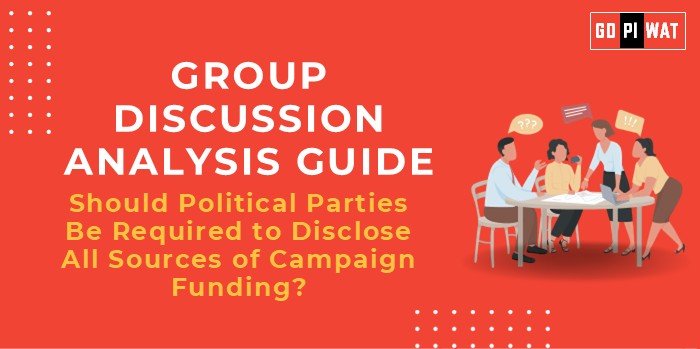📋 Group Discussion (GD) Analysis Guide: Should Political Parties Be Required to Disclose All Sources of Campaign Funding?
🌐 Introduction to the Topic
- Context: Campaign funding transparency is a hot topic in politics worldwide. The issue raises ethical, legal, and democratic questions as parties rely on large donations to finance campaigns.
- Background: India introduced the Electoral Bonds Scheme in 2018 to ensure donor anonymity while providing transparency in political donations. However, critics argue it has led to opacity, favoring ruling parties.
- Relevance: This topic highlights governance, accountability, and the balance between privacy and transparency—core themes for future business leaders and policymakers.
📊 Quick Facts and Key Statistics
- 💰 Electoral Bonds Purchased (2018-2024): ₹12,000 crore, 70% going to the ruling party.
- 🌍 India’s Transparency Ranking (2023): Ranked 85/180 in the Corruption Perceptions Index (Transparency International).
- 📜 Global Example: The U.S. mandates PACs to disclose donors exceeding $200.
- 📊 Voter Trust: 78% of voters believe undisclosed funding undermines democracy (Survey, 2023).
👥 Stakeholders and Their Roles
- 🏛️ Political Parties: Seek financial resources for campaigns; influenced by donors.
- 🤝 Donors: Individuals, corporates, and foreign entities; gain policy influence.
- 🗳️ Voters: Demand accountability; skeptical of opaque practices.
- ⚖️ Government & Election Commission: Regulates funding norms to ensure fairness.
- 📰 Civil Society & Media: Advocate for transparency and expose irregularities.
🏆 Achievements and Challenges
✨ Achievements:
- 📜 Electoral Bonds: Improved legitimacy of donations through formal banking channels.
- 📉 Limits on Spending: Restrictions reduced extravagant campaigning (₹70 lakh per candidate in Lok Sabha elections).
⚠️ Challenges:
- 🔍 Opaque Systems: Anonymity in electoral bonds fosters favoritism.
- 🏢 Corporate Influence: Major donors influence policy decisions.
- 🌐 Global Comparisons: The U.S. and U.K. have stricter donation disclosure laws.
📋 Structured Arguments for Discussion
- 👍 Supporting Stance: Transparency ensures accountability and prevents corruption in governance.
- 👎 Opposing Stance: Disclosure could deter donations due to fear of political retribution.
- ⚖️ Balanced Perspective: While transparency is critical, donor privacy and misuse concerns must also be addressed.
Example: “If political funding is disclosed, voters can make informed choices, fostering a healthier democracy.”
Example: “Full transparency may lead to donor hesitancy, impacting smaller parties disproportionately.”
Example: “A hybrid system—partial anonymity and stringent audits—could balance concerns.”
💬 Effective Discussion Approaches
- Opening Approaches:
- 📊 Use startling statistics: “₹12,000 crore in electoral bonds, 70% to one party, questions fairness.”
- 📜 Draw international parallels: “The U.S. caps anonymous donations at $200; should India follow?”
- Counter-Argument Handling:
- 📢 Privacy Concerns: Suggest encrypted audits to maintain donor confidentiality.
- 📈 Financial Disparities: Propose public funding to ensure fair competition.
🔍 Strategic Analysis: SWOT Framework
- 💡 Strengths: Enhances accountability; builds public trust.
- ⚠️ Weaknesses: Risk of donor intimidation; uneven party benefits.
- 🌟 Opportunities: Improve global ranking in transparency indices.
- ⚡ Threats: Overregulation could stifle smaller parties.
🎓 Connecting with B-School Applications
- 📚 Real-World Applications: Explore the topic through governance projects, CSR, and ethics modules.
- 🤔 Sample Interview Questions:
- How can transparency improve governance efficiency?
- What reforms would you suggest for political funding disclosure?
- 📖 Insights for Students: Analyze policy impact, draw comparisons, and integrate ethics in leadership.
📄 Source: GD and WAT preparation frameworks, 2024.


